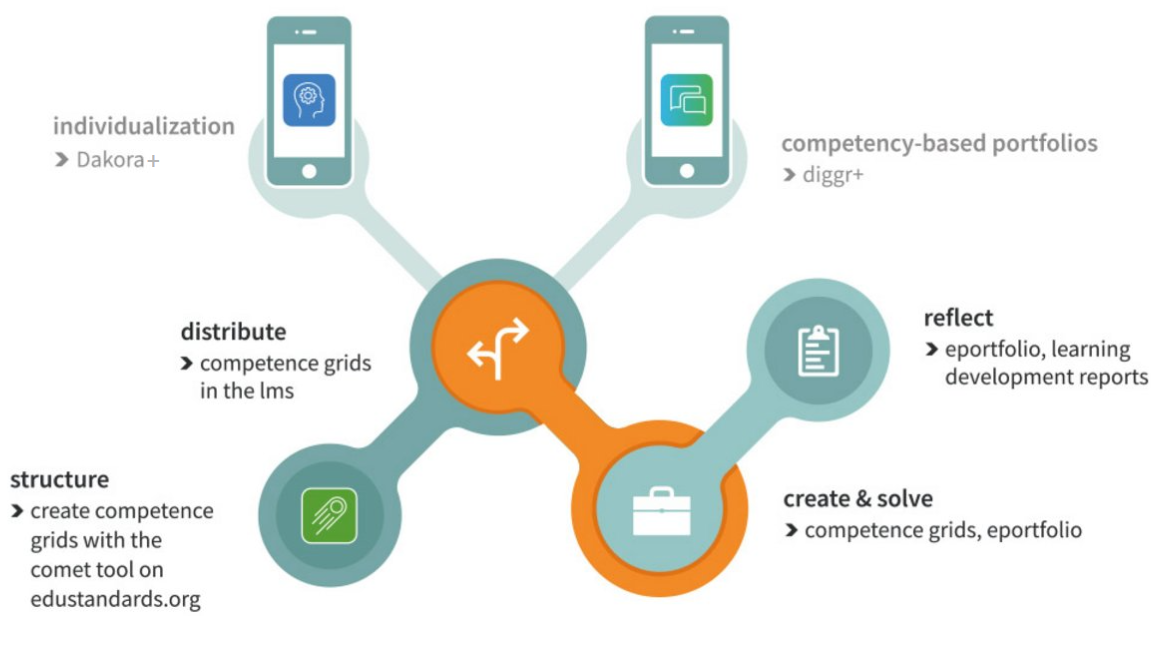Pedagogical concept
A key term in today’s classroom instruction is individualization. Students learn at their own pace and receive the materials they need to successfully grasp the learning content. Students are met where they currently stand!
In practice, this presents a major challenge for teachers.
Supporting students according to their individual abilities and prior knowledge can seem like an impossible task—especially with a large number of students.
This is precisely where the Exabis series comes in: with the help of digital tools, individualized learning in the classroom becomes possible.
The Exabis series combines competency grid-based learning with individualization and ePortfolio work. This means that educators can provide content within a structured competency framework, while students can independently demonstrate their knowledge in the respective competency areas.
In cooperation with the State Institute for School Development in Baden-Württemberg, this product series has been further developed on behalf of the Ministry of Education there and serves as a foundation for formative assessment and ongoing documentation of learning progress.
Exabis Competence Grids
The foundation of all Exabis applications is working with competence grids.
Competences are at the core of our module Exabis Competence Grids. Competences describe combinations of knowledge, abilities, and attitudes that are necessary, for example, for successful professional activity. It is important not to confuse competences with skills—skills refer to specific abilities needed for particular tasks, such as operating a machine, programming, etc.
Competence grids present subject areas in the form of a table or matrix. This format clearly and systematically displays the content to be taught to students, organised by levels of difficulty. Many teaching and learning materials are now being structured in this way. These grids also make it possible to illustrate the progress students make throughout their learning journey.
The module increases student motivation by linking activities and external resources to competences, and it promotes self-assessment as well as the demonstration of competences.
Exabis ePortfolio
An ePortfolio is an important element in individualized, self-directed learning, as it enables personalized creation and collection of content.
Using an ePortfolio allows students to document content in a self-directed manner. With the module functionality of Exabis ePortfolio, students can create digital folders and generate and store a wide variety of content within them: media, texts, images, links, etc.
The Exabis ePortfolio module thus enables both the documentation of content within the context of self-directed learning and the targeted sharing of content with peers or teachers.
Students can independently link their content to predefined competences – supporting competence-based learning in this context as well.
The module also allows users to create a CV that can be exported in Europass format, following an EU-wide standard.
As part of the open-source Exabis Suite, the ePortfolio module can be used in combination with the Exabis Competence Grid and Learning Development Report modules.
Exabis Student Review
In addition to various reports that show the status of learning development, the main focus of the module Exabis Student Review is on the assessment of students' cross-disciplinary competences. The development level of 21st-century skills, as well as personal and social competences, can be tracked and reviewed across courses by a team of teachers—either using a scale or through free-form feedback.
This module can be used independently or as part of the Exabis Suite, simplifying the assessment process and supporting personalized, competence-based learning paths.
Dakora+
Dakora+ is an educational app, designed to facilitate competency-based education and use individualized learning paths.
In every classroom, there are students who excel and students who fall behind. The former need more challenges, more tasks, and increased difficulty levels to progress. The latter need more structure, more instruction, and more assistance to keep up. Additionally, there is a large group of students who fall "in between," requiring a balance of both approaches.
Learning paths are essential for providing personalized education, allowing students to progress at their own pace and according to their needs. This approach enhances student engagement, motivation, and success especially for younger learners who require more structure and monitoring. It also reinforces the idea that students do not need to be the same; each can have their own preferences, working pace, needs, and challenges.
Our Dakora+ app makes creating and managing these learning paths smooth and efficient, without requiring excessive time and effort from teachers. Multiple projects? Multiple levels? With Dakora+, you can easily distribute materials and tasks to individual students and student groups.
With Dakora+ your students will:
- Understand and develop competencies through a clear, structured learning process.
- Achieve learning objectives at their own pace and take control of their schedule.
- Receive meaningful feedback and reflect on their learning process.
- Demonstrate proficiency and progress in various ways.
diggr+
Our app diggr+ is easy to use and facilitates portfolio-based pedagogy for maximum personalization and competence development. Students demonstrate proficiency in various ways, reflect on their learning process and collect artefacts of learning into their own individual digital portfolios.
Why ePortfolios?
tudents often lose motivation when their assignments end up forgotten in a drawer. Instead, these tasks could form part of their ePortfolios, showcasing their skills and competencies. Starting early means they will be well-prepared to present their achievements in future job interviews.
ePortfolios are ideal for older students who take more responsibility for their learning and have developed their own preferences and interests. Working with portfolios supports this by allowing students to demonstrate their skills and knowledge in diverse ways, preparing them for the labor market and enhancing their employability skills.
With diggr+, your students will:
- Gain a clear understanding of competencies through a structured learning process.
- Progress at their own pace and manage their schedules independently.
- Collect learning artefacts and reflect on their skills and knowledge.
- Receive constructive feedback and showcase their progress and proficiency in diverse ways.
- Take ownership of their learning journey and feel empowered to achieve their goals.
